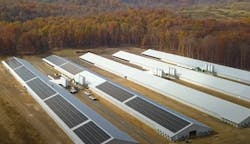West Virginia poultry farm gains 1,400-panel Solar Energy site
Renewable energy company Solar Holler has completed the installation of a solar system at Oak Tree Farm, a poultry farm in Hardy County in West Virginia.
Featuring nearly 1,400 solar panels, the system will provide the farm with 941,371 KWh of energy per year, making it the largest solar system so far in West Virginia.
"It's going to let them expand their operations and hire more West Virginians and bring more of our food production back into the states," said Dan Conant, founder and CEO at Solar Holler, in a YouTube video detailing the project.
According to the company, the system will deliver more than 99% of the electricity needed at the farm and help cut electricity cost by 10%.
The reduction in the cost of electricity will allow the farm to expand its operations and bring more jobs to the region, it adds.
The installation was financed by Skyview Ventures, a Tennessee-based renewable energy finance, development and asset management company.
About the Author
EnergyTech Staff
Rod Walton is head of content for EnergyTech.com. He has spent 17 years covering the energy industry as a newspaper and trade journalist.
Walton formerly was energy writer and business editor at the Tulsa World. Later, he spent six years covering the electricity power sector for Pennwell and Clarion Events. He joined Endeavor and EnergyTech in November 2021.
He can be reached at [email protected].
EnergyTech is focused on the mission critical and large-scale energy users and their sustainability and resiliency goals. These include the commercial and industrial sectors, as well as the military, universities, data centers and microgrids.
Many large-scale energy users such as Fortune 500 companies, and mission-critical users such as military bases, universities, healthcare facilities, public safety and data centers, shifting their energy priorities to reach net-zero carbon goals within the coming decades. These include plans for renewable energy power purchase agreements, but also on-site resiliency projects such as microgrids, combined heat and power, rooftop solar, energy storage, digitalization and building efficiency upgrades.
